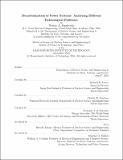Decarbonization of power systems : analyzing different technological pathways
Author(s)
Sepulveda, Nestor A. (Sepulveda Morales)
DownloadFull printable version (19.21Mb)
Other Contributors
Technology and Policy Program.
Advisor
Richard K. Lester, Charles W. Forsberg and Fernando J. de Sisternes.
Terms of use
Metadata
Show full item recordAbstract
Climate change poses a major challenge to society. Different sectors of society will need to respond in different ways; for the power sector, the response will require the aggressive reduction of CO2 emissions to near zero by 2050. There is no unique pathway for achieving a given level of decarbonization, and different pathways will require greater or lesser resources. In general, as the degree of carbon mitigation increases, each additional unit of reduction will become more expensive. The world has limited resources, as do national economies. Thus, whether the solution to decarbonization is achieved through markets or through centralized planning, the solution should be the one that maximizes society's welfare, i.e., that achieves the goal at minimum cost for society. This thesis explores the potential cost implications of different decarbonization pathways for the electricity generation mix in the year 2050. The impacts of different CO2 reduction targets and technological choices on the cost of decarbonization are compared. The average price of electricity is used as a metric for the cost of decarbonization to society. An important requirement of the analysis is to take account of changes in the expected cost of existing technologies over this period, as well as the possibility that new technologies will become available. This research takes a systemic view, including a detailed representation of the interactions between different types of power system technologies, taking into consideration the synergies and limitations that each asset class creates and/or imposes on others. To explore the impact of differences in system characteristics, two different U.S. power systems are analyzed: New England's power system and the Texas power system. These differ significantly in their demand profiles and in the availability of renewable resources. Cost estimates developed by the International Energy Agency and the Nuclear Energy Agency for 2020 are used as input parameters for the analysis. Uncertainty in cost estimates is addressed by a comprehensive sensitivity analysis on future cost reductions for renewables and storage systems, as well as future cost increases for nuclear technologies. Additionally, to account in part for the likelihood of future changes in the pool of available technological options, two new supply-side technologies currently under development are included in the analysis, as are new capabilities for managing demand-side resources. A novel long-term generation investment model, GenX, has been developed to determine the minimum cost generation mix subject to various emissions constraints and different technological pathways. GenX is a capacity expansion model with clustered unit commitment constraints whose main features include: 1) the ability to evaluate the impact of operating constraints with hourly resolution on investment decisions and on total generation cost; 2) the ability to account for the chronological variability of demand and renewable output, and correlations between the two; and 3) the ability to decide on power plant investments and operation at the individual plant level. Each technology is characterized by a particular set of operational and economic parameters. Additionally, GenX is capable of modeling new technological concepts {advanced nuclear (Generation IV) and heat storage{ which would support interactions between electricity and heat markets. The model is implemented in the Julia language and has been used to simulate 560 different decarbonization/technology scenarios. Key results include: (1) the importance for minimizing the cost of decarbonization of having a diversity of technological options with a range of technical and economic attributes; more specifically, (2) the central importance of having dispatchable low-carbon resources, such as nuclear power or carbon capture and sequestration systems. For example, when dispatchable low-carbon technologies are not available, the cost of achieving deep decarbonization goals is shown to triple in power systems such as New England's with lower renewables potential, and to double even in a Texas-like system with higher renewables potential; and (3) the great potential of new technological concepts for simultaneously reducing CO2 emissions and decreasing the cost of electricity considerably. An important policy implication of this work is the need to shift from technology-specific support mechanisms for decarbonization (e.g. renewable portfolio standards) to general low-carbon support mechanisms that will allow for competition between and adaptation of low-carbon technologies. The methodology developed in this research supports two important new capabilities for policy makers: (1) the ability to calculate the extra cost associated with dispensing with specific technological options {such as nuclear power{ will enable improved cost-benefit analysis of policies directed towards specific technologies; (2) the ability to model the potential impact of new technological concepts on the cost of decarbonization will help to optimize the allocation of R&D resources with respect to their potential contribution to reducing CO2 abatement costs.
Description
Thesis: S.M., Massachusetts Institute of Technology, Department of Nuclear Science and Engineering, 2016. Thesis: S.M. in Technology and Policy, Massachusetts Institute of Technology, School of Engineering, Institute for Data, Systems, and Society, Technology and Policy Program, 2016. This electronic version was submitted by the student author. The certified thesis is available in the Institute Archives and Special Collections. Cataloged from student-submitted version of thesis. Includes bibliographical references (pages 211-214).
Date issued
2016Department
Massachusetts Institute of Technology. Department of Nuclear Science and Engineering; Massachusetts Institute of Technology. Engineering Systems Division; Massachusetts Institute of Technology. Institute for Data, Systems, and Society; Technology and Policy ProgramPublisher
Massachusetts Institute of Technology
Keywords
Nuclear Science and Engineering., Institute for Data, Systems, and Society., Engineering Systems Division., Technology and Policy Program.